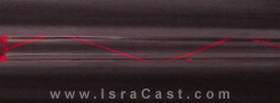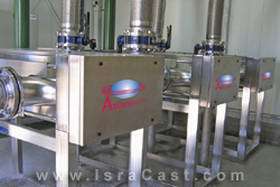Out of the Box Thinking Produces Safer Water

An Israeli company developed a new technology for water disinfection. It uses ultra violet (UV) light to disinfect water and is 10,000 more effective then existing techniques. With impending regulatory changes in the U.S. and other countries, the move from chemical disinfectants to green non-toxic advanced disinfection solutions can improve the safety of the water while reducing its cost. The new system is also strong enough to kill the kind of biological agents bio-terrorists might use inside water reservoirs.
This picture illustrates how Atlantium system reflects UV photons that hit the quartz chamber wall and reuses them to enhance the efficiency and impact of the germicidal rays.
Pure drinking water is a highly important resource not only in Africa and many developing countries but also in many Western countries where the quality of water is falling short of the accepted standards. This is on top of the soaring maintenance costs of existing water treatment systems, which use chemicals now known to be carcinogenic. Layer that with the limited capability systems have to handle some of the most hazardous microbes commonly found in drinking water (not to mention biological agents that could be used by terrorists) and the need for a new generation of water treatment systems becomes abundantly clear.
Enter a young and ambitious Israeli company called Atlantium which over the last two years developed a remarkable new way of using UV light to disinfect large quantities of water to a level unheard of before using existing methods.
There are three main methods for disinfecting water: the most common method (over 50% of the world market) uses various chemicals such as chlorine to kill biological agents. Although this method is wide spread and have been practiced all over the world for many years it has a number of important disadvantages, mainly toxicity (research has shown that some chemicals kill the bacteria in the water only to create carcinogenic by-products), and their inability to kill some forms of dangerous bacteria (such as Cryptosporidium). Another important disadvantage is that the chemicals themselves are dangerous to handle and can cause a variety of environmental issues (from transporting these chemicals on busy roads to dumping their contaminating waste products in the ground).
A less common water treatment method is “microfiltration” that actively blocks some of the bacteria. Although this method can be rather effective, its capital and especially running costs are considerable due to high maintenance requirements (the filters have to be cleaned or replaced every so often). Many filter systems need a constant high water pressure to force the water through the filter, and the high energy costs make these water treatment systems less attractive.
The third and most advanced method of disinfecting water is with UV light. The UV does not kill or remove the bacteria but rather inactivates the DNA so the bacteria can’t reproduce. UV systems usually do not consume large amounts of energy and are considered environmentally friendly. However, a number of difficulties have plagued this technology and restricted its wide spread adoption. Existing UV systems use UV lamps that are immersed in the water. This causes a variety of problems, starting from uneven scattering of the UV rays leading to lower inactivation, increase in local temperature near the immersed UV lamps causing scaling and resulting in high maintenance costs. Existing UV systems clean this fouling with brushes or wipers, which in turn are often a breading ground for bacteria.
To avoid these problems, Atlantium developed an entirely new UV system that puts an advanced UV source outside the flow of the water. In order to achieve effective inactivation the Atlantium system uses a quartz tube as its reactor and bombards the flowing water with homogeneous dosages of UV radiation. Using the same principle as fiber optic technology, quartz walls of the tube reflect the UV light so it reaches every drop of water effectively. This method actively eliminates all of the drawbacks of existing UV technology. By taking the UV source out of the water and projecting it into the quartz chamber, Atlantium's engineers are able to supply homogeneous distribution of the UV rays, eliminate the local heating and thus the scale and fouling, as well as the need for brushes to clean the chamber. Controlling the temperature of the external UV lamp (not possible when the lamp is in the water) helps control the power needed by the light source and reduce operating and maintenance costs.
In various tests conducted by the company using different species of microbes, spores and other microscopic life forms, the system was able to inactivate water born organisms four orders of magnitude more effectively then existing UV systems, meaning that on average only one in 10,000,0000 organisms escaped inactivation. (Measuring such small numbers itself can be difficult, and is generally considered “total kill”) This superior performance combined with the system’s ability to disinfect about 1 million gallons of water a day (approximately 150 cubic meter an hour) while consuming only 2.5 kW·h, turns the Atlantium system into one of the most efficient and cost effective systems in the world.

The new system has many potential markets, from the water companies across the world that supply drinking water to the general population to the food and beverage industry which requires large quantities of safe disinfected water in products and in cleaning containers, processing tubes, etc. In the beer industry for example producing each beer bottle requires the equivalent of ten bottles of safe water. In fact, the early adopters of the Atlantium system include Tnuva, the Israeli owner of the largest dairy in the Middle East. They purchased the system to achieve longer shelf life for its products, better product quality as well as compliance with environmental standards. Another customer, a Turkish company, specializes in breeding fish (which are highly sensitive to microbes). Atlantium is currently making its way to markets in Italy, Spain, Germany, England, Canada, China, Singapore and the U.S.
Although the current market for UV purification systems is only 30% of the total market for drinking water treatment technologies, this number is expected to rise dramatically over the next few years due to several new strict standards the U.S. Environmental Protection Agency will finalize in 2006. These new regulations will require drinking water to be protected against cryptosporidium and other pathogens (which chlorine can’t do effectively) and to reduce disinfection by products commonly associated with chlorine and ozone treatments. UV is currently considered the best option for municipalities and water utility operators across the U.S. Developing countries are interested too so they can use advanced treatment technologies instead of subjecting their ecosystems to the hazards of chlorine. On our visit to Atlantium's laboratories David Waxman, Atlantium CEO, told IsraCast that out of an annual market of about 5 billion dollars for water disinfection systems around the world, more than 1 billion dollars goes into UV based systems, and that the new US rules and a global consensus to avoid disinfection by-products should increase this number dramatically over the next few years.
Special thanks to Phyllis Butler Posy, Director of Business Development Atlantium Company, for her help on this article.
by Iddo Genuth - IsraCast
The original story can be found at http://www.isracast.com/tech_news/240805_tech.htm
For any comments about this story, please contact the writer of the original article
© 2005 IsraCast. Published with permission of Iddo Genuth
















